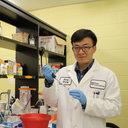Promoter difference of LcFT1 is a leading cause of natural variation of flowering timing in different litchi cultivars (Litchi chinensis Sonn.).
Түлхүүр үгс
Хураангуй
Litchi (Litchi chinensis) is an important subtropical evergreen fruit crop with high commercial value due to its high nutritional values and favorable tastes. However, irregular bearing attributed to unstable flowering is a major ongoing problem for litchi producers. There is a need to better understand the genetic and molecular mechanisms underlying the reproductive process in litchi. In a previous study, our laboratory had analyzed the transcriptome of litchi leaves before and after low-temperature treatment with RNA-seq technology. Herein, we demonstrated that litchi flowering was induced by low-temperature and identified two FLOWERING LOCUS T (FT) homologue genes named LcFT1 and LcFT2, respectively. We found that low-temperature could only induce LcFT1 expression in leaves, but could not induce LcFT2 expression. Heterologous expression of LcFT1 in transgenic tobacco and Arabidopsis plants induced their precocious flowering. These results indicate that LcFT1 plays a pivotal role in litchi floral induction by low-temperature. In addition, we found that two types of LcFT1 promoter existed in different litchi cultivars. The LcFT1 promoters in the early-flowering cultivars belonged to one type whereas LcFT1 promoters in the late-flowering belonged to another one. LcFT1 promoter in the early-flowering cultivars was more sensitive to low-temperature than that of the late-flowering cultivars was, which may be caused by the different cis-acting elements, including MYC, MYB, ABRE, and WRKY cis-acting elements, which were found to be present in the LcFT1 promoter sequences of the early-flowering cultivars. This difference may be responsible for the different requirements of low-temperature for floral induction in the early- and late-flowering cultivars of litchi. Taken together, the difference in LcFT1 promoter sequences may be one of the leading cause for the natural variation of flowering timing in different litchi cultivars. Our study has provided valuable genetic basis for cross-breeding of litchi cultivars to generate new litchi cultivars for overcoming the problem of unstable flowering for litchi producers.



